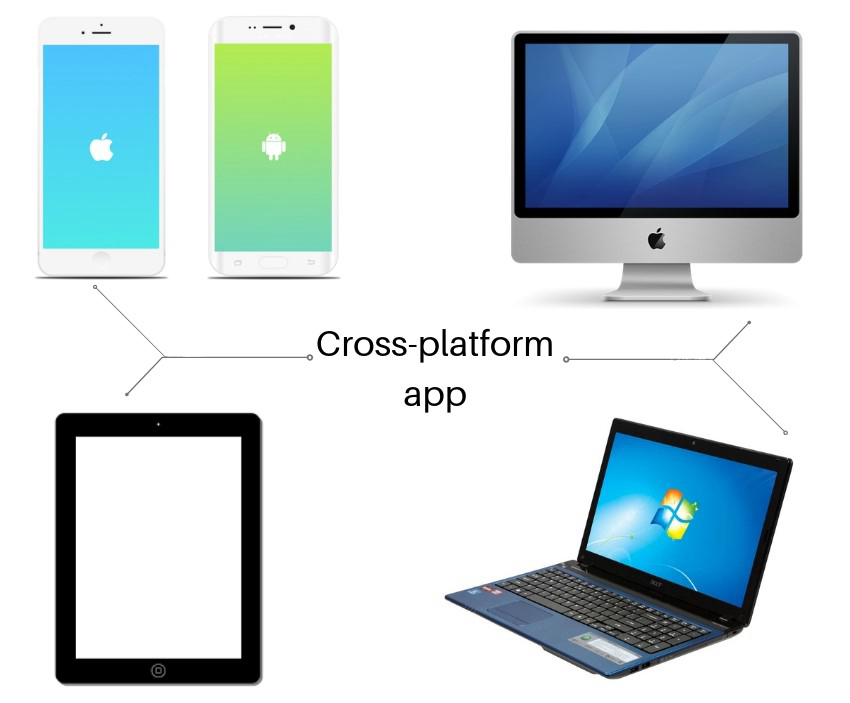Everything you need to know about cross-platform apps

Let’s say you’ve got a mobile app idea that you want to implement. Now, which platform should you start from – Android or iOS? Or maybe both? To reach as many users as possible, there are two choices. You can either build a standalone native app for each mobile OS or develop a single cross-platform solution for both of them.
In this article, we will give you a brief explanation of what is cross-platform app development and how it can benefit you. So let’s dive in!
What is a cross-platform app?
“Сross-platform software (also multi-platform software or platform-independent software) is computer software that is implemented on multiple computing platforms.” Wikipedia
A cross-platform application is the one that can run on many operating systems. From the development point of view, for example, for iOS and Android, you write one code and just make two builds (with the same code under the skin). In fact, you can reuse up to 90% of code and use the rest 10% to add platform-specific features. While with native app development you actually need to develop two standalone apps.
To build the cross-platform application, you usually need a JavaScript or C++ developer with knowledge of cross-platform frameworks.
Top cross-platform app development frameworks
Ionic
This open-source SDK is based on Javascript. It includes a rich library of blocks for front-end development and UI components. As a result, your app works equally well on mobile and on the web. Ionic doesn’t replace PhoneGap or other JS frameworks but works together with them.
Qt
8 of 10 top companies in Fortune 500 list use Qt in their development, states Qt team. This cross-platform framework makes the app run on Android, iOS, Windows, Linux, macOS, watchOS, smartTV and more. Qt is a C++ framework with rich libraries and easy-to-use APIs. The tool makes development much easier and faster. It also allows building high-performing app UIs.
React Native
It’s based on JS and doesn’t need any additional tools for development. React Native uses the same UI components as native iOS or Android apps do, which gives the native look to your app. No wonder that 18.76% of installed apps were created with React Native.
Xamarin
This framework is based on C# language and uses native views for UI rendering. With its help, you can build apps for iOS, Android and macOS. Xamarin lets you access platform native APIs and add the native functionality as well.
PhoneGap
This framework by Apache Cordova has a large developer community. PhoneGap plugins and toolset ensure that your app looks and functions just like a native app would.
The key benefits of cross-platform application development
1. Minimize the cost of development.
If your app doesn’t involve very complex UI, cross-platform development will be almost twice cheaper than building native applications. That’s because you cut a huge amount of developer’s work needed to launch two or more native solutions. According to HackerNoon, the savings amount varies from 10 000 for small MVPs to 100 000 for large enterprises.
2. Save time.
The exact amount of time you can save depends on your app scope, its purpose and features. In fact, it can reach 30% of development time, states Research2Guidance.
3. Simplify maintenance.
Maintaining the app will cost less and be easier since you will have only one code version for all platforms. All changes will be synced between different OS simultaneously.
4. Reach more users with fewer efforts.
With a single app version, you can reach your users across mobile, desktop and even smart devices. Qt framework makes this possible. For instance, some content delivery or business apps should be in easy access anywhere.
Cross-platform app development – the key pitfalls
Whether you’re a small startup or a large company, keep in mind these challenges when building your cross-platform app.
Platform limits
To give your app the native device appearance, additional coding might be required. The more platform-specific features you need, the more work it will require. Since each platform has its native-only features & functionality, this can imply some limits to developers and additional work.
Hard-to-find skills
It might be challenging to find Ionic developers or PhoneGap programmers since these tools were launched relatively recently. However, it may be a bit easier to hire Qt developers instead.
Potentially more bugs
Although there is no bug-free code, native apps usually have fewer issues than cross-platform apps. Cross-platform apps add another complexity layer to your software. This can potentially bring more bugs, especially to large-scale apps. However, you can fix any of them with proper testing before release.
Let us give you some examples.
Tesla, Skype and Walmart all used cross-platform mobile development since it matched their needs. Tesla users can now control their cars on Android or iOS devices with equally seamless UX and through the same features. Skype launched a new project called “Skype for life”. It’s available on iOS, Android, macOS, Linux and Windows.
Walmart reused 95% of code and introduced a high-performing shopping app with a native-like UI. This wouldn’t be possible without React Native framework.
Facebook Ads Manager is also cross-platform. Thanks to this, businesses can monitor their ad performance no matter where they are and what device they use.
As you can see, each cross-platform app has the customers need or business strategy behind it.
To sum up
So we’ve highlighted the most valuable information to know before going for cross-platform development. Now you can pay attention to your app size, UI and goals to make a wise decision. Just remember to choose a cross-platform development company you can trust. With their help, you can get answers to your questions and the help of experts.





